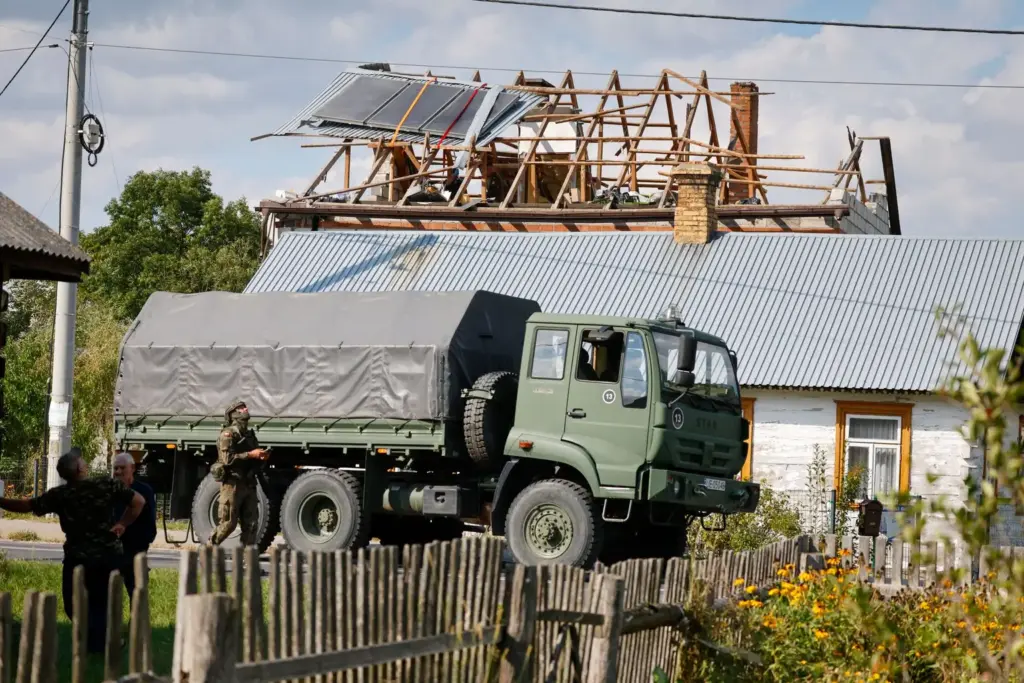
Political tensions in Poland are escalating following reports that damage to a home during Russia’s drone incursion on September 10 may have been caused by a Polish missile. The incident in the village of Wyryki, initially attributed to a Russian drone, is now under scrutiny after a report by the Polish media outlet Rzeczpospolita suggested that an AIM-120 Advanced Medium-Range Air-to-Air Missile from a Polish F-16 fighter jet might be responsible.
The missile reportedly failed to deploy correctly while defending Polish airspace from Russian drones, according to Rzeczpospolita, which cited findings from state security agencies. A source indicated that the missile did not explode because “the fuse’s safety devices were activated.” The Kyiv Independent has not yet verified these claims.
The home, located approximately 20 kilometers from the Ukrainian border, sustained damage to its roof and a car parked on the property, as reported by Polsat News. Fortunately, no casualties were reported in the incident.
Largest Attack on NATO Territory
On September 10, twenty-one Russian drones crossed into Poland, marking the largest attack on a NATO member since the onset of Moscow’s full-scale war against Ukraine. This incursion has heightened concerns about regional security and the potential for further escalations.
In response to the reports, Poland’s National Security Bureau issued a statement on behalf of President Karol Nawrocki, urging the government to “immediately clarify the incident.” The statement emphasized the need for transparency and accuracy in communication to counter disinformation and hybrid warfare.
“It is up to the Government to use all available tools and institutions to explain this matter as quickly as possible. There can be no consent to withholding information,” the agency stated.
Political Repercussions and Responses
Polish Prime Minister Donald Tusk responded to the calls for clarification by deflecting responsibility back to Russia, citing its violation of Polish airspace as the root cause of the incident. “All responsibility for the damage to the house in Wyryki rests with the perpetrators of the drone provocation, namely Russia,” Tusk wrote on X, formerly known as Twitter. He assured the public that information on the incident would be disclosed following an investigation.
“Hands off Polish soldiers,” Tusk concluded, addressing Nawrocki’s earlier comments.
The exchange underscores the political divisions within Poland, as Nawrocki, a right-wing nationalist, has frequently clashed with Tusk since his election earlier this year. These tensions reflect broader social and political divides within the country.
International Reactions and NATO’s Role
Ukrainian Foreign Ministry spokesperson Heorhii Tykhyi cautioned against questioning Russia’s responsibility for the airspace violation. This comes after Slovak Foreign Minister Juraj Blanar expressed hope that the drones were not intended to attack Poland but were meant for Ukraine.
Poland’s Operational Command of the Armed Forces has assured that it is providing “all available information and subsequent conclusions from the analysis of the incident” to relevant authorities continuously and without omission.
In response to the incursion, NATO has launched its Eastern Sentry mission, aimed at preventing further Russian interference in the airspace of alliance members. This mission represents a significant step in NATO’s efforts to bolster its eastern flank and deter potential aggression.
Looking Ahead
The evolving situation in Poland highlights the complexities of regional security dynamics in Eastern Europe. As investigations continue, the incident serves as a reminder of the fragile nature of international relations in the area and the potential for rapid escalation.
With NATO’s involvement and the Polish government’s commitment to transparency, the coming weeks will be critical in determining the full implications of the incident and ensuring that similar occurrences are prevented in the future.







